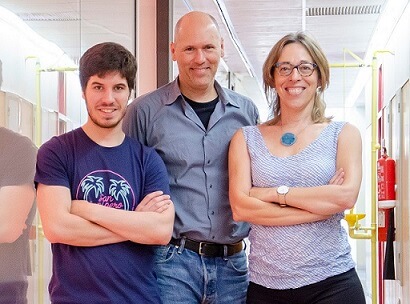Lines of investigation
Brain function generates cognition, thought and adaptive behaviors through coordinated actions of circuits that are hard-wired during development with others that retain remarkable plasticity into adulthood. A fundamental question is how experiences shape these neural circuits, so the individual learns and interacts adequately with its environment. Over postnatal stages, most remodeling involves formation, strengthening or elimination of synapses to build, maintain or reshape neural assemblies. Synaptic remodeling occurs throughout life but is maximal during “so-called” critical periods—a stage of postnatal development when synapses have a high potential for plasticity and massive formation and elimination of synapses refines initially redundant circuitry. Yet this plasticity potential needs to be “tamed” so the correct synaptic partners are specified during postnatal circuit refinements and to support precise learning and cognitive-guided behaviors. Understanding how this is achieved is one major goal of our lab.
A central research theme stems from our discovery of a class of NMDA receptors, defined by the presence of non-conventional GluN3A subunits, that work as gate-keepers of experience-dependent plasticity and synaptic refinements (Nature Rev Neuroscience 2016). Transient waves of GluN3A expression are typical of primary or sensory cortical areas and guide the hard-wiring of sensory circuits. By contrast, adult expression is retained into adulthood in less-differentiated association and trans-modal cortical areas, high-order thalamic nucleus and regions engaged in emotional control (Cerebral Cortex 2021). In the last years, we have generated a collection of mouse genetic tools to map cellular populations, circuits and behaviours that rely on GluN3A plasticity and understand its role in functional integration.
Other areas of investigation include:
1) Targeting circuit plasticity and cognition: Neurons rely on translational control to direct persistent modifications to selected synapses, but the mechanisms affording synapse and temporal specificity had been elusive. We have discovered neuronal GIT1/mTORC1 complexes that nucleate protein synthesis at synapses and whose assembly is negatively regulated by GluN3A expression, imposing limits on memory capacity. Regulated interactions between GluN3A and GIT1 determine which memories will be persistently stored, opening an entry point for modulating cognition (eLife 2021).
2) Identifying plasticity niches in non-neuronal cells
Representative Publications
- Parallel processing of quickly and slowly mobilized reserve vesicles in hippocampal synapses. Rodriguez Gotor J J, Mahfooz K, Perez-Otano I & Wesseling J F. eLife 2024 12: RP88212 https://doi.org/10.7554/eLife.88212
- Synaptic and extrasynaptic distribution of NMDA receptors in the cortex of Alzheimer’s disease patients. Escamilla S, Badillos R, Comella JX, Solé M, Pérez-Otaño I, Sánchez Mut JV, Sáez-Valero J and Cuchillo-Ibáñez I. Alzheimer's & Dementia 2024 1-15 (in press) https://doi.org/10.1002/alz.14125
- GluN3A subunit tunes NMDA receptor synaptic trafficking and content during postnatal brain development. Gonzalez-Gonzalez, IM, Gray, JA, Ferreira, J., Conde-Dusman, MJ, Bouchet, D., Pérez-Otaño, I *, Groc L. Cell Rep . 2023 42 (5): 112477 https://doi.org/10.1016/j.celrep.2023.112477
- GluN3A excitatory glycine receptors control adult cortical and amygdalar circuits. Bossi, S., Dhanasobhon, D., Ellis-Davies, G.C.R., Frontera, J., de Brito Van Velze, M., Lourenço, J., Murillo, A., Luján, R., Casado, M., Perez-Otaño, I., Bacci, A., Popa, D., Paoletti, P., Rebola, N. Neuron . 2022 110 (15) :2438-2454.e8. https://doi.org/10.1016/j.neuron.2022.05.016
- Elevated synaptic vesicle release probability in synaptophysin/gyrin family quadruple knockouts Raja MK, Preobraschenski J, Del Olmo-Cabrera S, Martinez-Turrillas R, Jahn R, Perez-Otano I, Wesseling JF eLife 2019 8:e40744 https://doi.org/10.7554/eLife.40744
- Sparse force-bearing bridges between neighboring synaptic vesicles Wesseling JF, Phan S, Bushong EA, Siksou L, Marty S, Pérez-Otaño I, Ellisman M Brain Struct Funct 2019 224(9):3263 https://doi.org/10.1007/s00429-019-01966-x
- RNAi-Based GIuN3A Silencing Prevents and Reverses Disease Phenotypes Induced by Mutant huntingtin Marco S, Murillo A, Pérez-Otaño I Mol Ther 2018 26(8):1965 https://doi.org/10.1016/j.ymthe.2018.05.013
- Emerging roles of GluN3-containing NMDA receptors in the CNS Perez-Otaño I, Larsen RS, Wesseling JF Nat Rev Neurosci 2016 17(10):623 https://doi.org/10.1038/nrn.2016.92
- GluN3A expression restricts spine maturation via inhibition of GIT1/Rac1 signaling Maria Fiuza, Immaculada González-González, and Isabel Pérez-Otaño PNAS 2013 110(51): 20807 https://doi.org/10.1073/pnas.1312211110
- Synaptic and extrasynaptic distribution of NMDA receptors in the cortex of Alzheimer’s disease patients. Escamilla S, Badillos R, Comella JX, Solé M, Pérez-Otaño I, Sánchez Mut JV, Sáez-Valero J and Cuchillo-Ibáñez I. Alzheimer's & Dementia 2024 1-15 (in press) https://doi.org/10.1002/alz.14125
- Parallel processing of quickly and slowly mobilized reserve vesicles in hippocampal synapses. Rodriguez Gotor J J, Mahfooz K, Perez-Otano I & Wesseling J F. eLife 2024 12: RP88212 https://doi.org/10.7554/eLife.88212
- No evidence for cognitive decline or neurodegeneration in strain-matched Grin3a knockout mice. Remy Verhaeghe, Oscar Elía-Zudaire, Sergio Escamilla, Javier Sáez-Valero, Isabel Pérez-Otaño Alzheimer's & Dementia. 2023 19 (9), pp. 4264 - 4266 https://doi.org/10.1002/alz.13375
- Monitoring Fine and Associative Motor Learning in Mice Using the Erasmus Ladder. Staffa, A., Chatterjee, M., Diaz-Tahoces, A., Leroy, F., Perez-Otaño, I. J. Vis. Exp. 2023 e65958 https://doi.org/10.3791/65958
- GluN3A subunit tunes NMDA receptor synaptic trafficking and content during postnatal brain development. Gonzalez-Gonzalez, IM, Gray, JA, Ferreira, J., Conde-Dusman, MJ, Bouchet, D., Pérez-Otaño, I *, Groc L. Cell Rep . 2023 42 (5): 112477 https://doi.org/10.1016/j.celrep.2023.112477
- GluN3A NMDA receptor subunits: more enigmatic than ever?. Crawley O, Conde-Dusman MJ,Perez-Otano I. J Physiol (London). 2022 600(2): 261-276 - Review https://doi.org/10.1113/JP280879
- Ubiquitin ligase activity inhibits Cdk5 to control axon termination. Desbois, M., Opperman, K.J., Amezquita, J., Gaglio, G., Crawley, O., Grill, B. PLoS Genet . 2022 18(4): e1010152 https://doi.org/10.1371/journal.pgen.1010152
- GluN3A excitatory glycine receptors control adult cortical and amygdalar circuits. Bossi, S., Dhanasobhon, D., Ellis-Davies, G.C.R., Frontera, J., de Brito Van Velze, M., Lourenço, J., Murillo, A., Luján, R., Casado, M., Perez-Otaño, I., Bacci, A., Popa, D., Paoletti, P., Rebola, N. Neuron . 2022 110 (15) :2438-2454.e8. https://doi.org/10.1016/j.neuron.2022.05.016
- Autophagy in axonal and presynaptic development Crawley O, Grill B Curr Opin Neurobiol 2021 69:139 https://doi.org/10.1016/j.conb.2021.03.011
- Temporal Dynamics and Neuronal Specificity of Grin3a Expression in the Mouse Forebrain Murillo A, Navarro AI, Puelles E, Zhang Y, Petros TJ, Pérez-Otaño I Cereb Cortex 2021 31(4):1914 https://doi.org/10.1093/cercor/bhaa330
- Control of protein synthesis and memory by GluN3A-NMDA receptors through inhibition of GIT1/mTORC1 assembly. Conde-Dusman MJ, Dey PN, Elía-Zudaire Ó, Rabaneda LG, García-Lira C, Grand T, Briz V, Velasco ER, Andero R, Niñerola S, Barco A, Paoletti P, Wesseling JF, Gardoni F, Tavalin SJ, Perez-Otaño I eLife 2021 10:e71575 https://doi.org/10.7554/eLife.71575
- Sparse force-bearing bridges between neighboring synaptic vesicles Wesseling JF, Phan S, Bushong EA, Siksou L, Marty S, Pérez-Otaño I, Ellisman M Brain Struct Funct 2019 224(9):3263 https://doi.org/10.1007/s00429-019-01966-x
- Presynaptic NMDARs and astrocytes ally to control circuit-specific information flow Perez-Otano I, Rodriguez-Moreno A Proc Natl Acad Sci USA 2019 116(27):13166 https://doi.org/10.1073/pnas.1908293116
- Elevated synaptic vesicle release probability in synaptophysin/gyrin family quadruple knockouts Raja MK, Preobraschenski J, Del Olmo-Cabrera S, Martinez-Turrillas R, Jahn R, Perez-Otano I, Wesseling JF eLife 2019 8:e40744 https://doi.org/10.7554/eLife.40744
- RNAi-Based GIuN3A Silencing Prevents and Reverses Disease Phenotypes Induced by Mutant huntingtin Marco S, Murillo A, Pérez-Otaño I Mol Ther 2018 26(8):1965 https://doi.org/10.1016/j.ymthe.2018.05.013
- TFOS DEWS II Report Executive Summary Craig JP, Nelson JD, Azar DT, Belmonte C, Bron AJ, Chauhan SK, de Paiva CS, Gomes JAP, Hammitt KM, Jones L, Nichols JJ, Nichols KK, Novack GD, Stapleton FJ, Willcox MDP, Wolffsohn JS, Sullivan DA Ocul Surf 2017 15(4):802 https://doi.org/10.1016/j.jtos.2017.08.003
- Emerging roles of GluN3-containing NMDA receptors in the CNS Perez-Otaño I, Larsen RS, Wesseling JF Nat Rev Neurosci 2016 17(10):623 https://doi.org/10.1038/nrn.2016.92
- GluN3A expression restricts spine maturation via inhibition of GIT1/Rac1 signaling Maria Fiuza, Immaculada González-González, and Isabel Pérez-Otaño PNAS 2013 110(51): 20807 https://doi.org/10.1073/pnas.1312211110

 Español
Español



